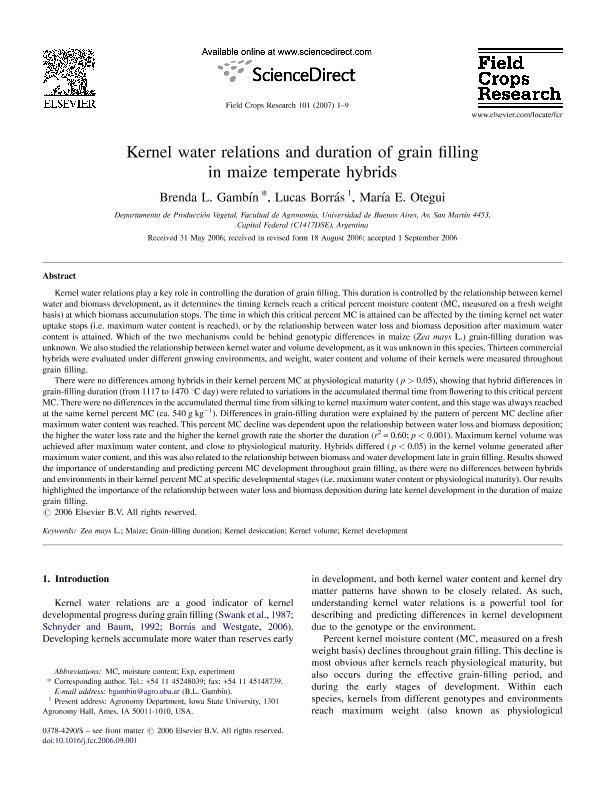Artículo
Kernel water relations and duration of grain filling in maize temperate hybrids
Fecha de publicación:
02/2007
Editorial:
Elsevier Science
Revista:
Field Crops Research
ISSN:
0378-4290
Idioma:
Inglés
Tipo de recurso:
Artículo publicado
Clasificación temática:
Resumen
Kernel water relations play a key role in controlling the duration of grain filling. This duration is controlled by the relationship between kernel water and biomass development, as it determines the timing kernels reach a critical percent moisture content (MC, measured on a fresh weight basis) at which biomass accumulation stops. The time in which this critical percent MC is attained can be affected by the timing kernel net water uptake stops (i.e. maximum water content is reached), or by the relationship between water loss and biomass deposition after maximum water content is attained. Which of the two mechanisms could be behind genotypic differences in maize (Zea mays L.) grain-filling duration was unknown. We also studied the relationship between kernel water and volume development, as it was unknown in this species. Thirteen commercial hybrids were evaluated under different growing environments, and weight, water content and volume of their kernels were measured throughout grain filling. There were no differences among hybrids in their kernel percent MC at physiological maturity (p > 0.05), showing that hybrid differences in grain-filling duration (from 1117 to 1470 °C day) were related to variations in the accumulated thermal time from flowering to this critical percent MC. There were no differences in the accumulated thermal time from silking to kernel maximum water content, and this stage was always reached at the same kernel percent MC (ca. 540 g kg-1). Differences in grain-filling duration were explained by the pattern of percent MC decline after maximum water content was reached. This percent MC decline was dependent upon the relationship between water loss and biomass deposition; the higher the water loss rate and the higher the kernel growth rate the shorter the duration (r2 = 0.60; p < 0.001). Maximum kernel volume was achieved after maximum water content, and close to physiological maturity. Hybrids differed (p < 0.05) in the kernel volume generated after maximum water content, and this was also related to the relationship between biomass and water development late in grain filling. Results showed the importance of understanding and predicting percent MC development throughout grain filling, as there were no differences between hybrids and environments in their kernel percent MC at specific developmental stages (i.e. maximum water content or physiological maturity). Our results highlighted the importance of the relationship between water loss and biomass deposition during late kernel development in the duration of maize grain filling.
Archivos asociados
Licencia
Identificadores
Colecciones
Articulos(IFEVA)
Articulos de INST.D/INV.FISIOLOGICAS Y ECO.VINCULADAS A L/AGRIC
Articulos de INST.D/INV.FISIOLOGICAS Y ECO.VINCULADAS A L/AGRIC
Articulos(OCA PQUE. CENTENARIO)
Articulos de OFICINA DE COORDINACION ADMINISTRATIVA PQUE. CENTENARIO
Articulos de OFICINA DE COORDINACION ADMINISTRATIVA PQUE. CENTENARIO
Citación
Gambin, Brenda Laura; Borras, Lucas; Otegui, Maria Elena; Kernel water relations and duration of grain filling in maize temperate hybrids; Elsevier Science; Field Crops Research; 101; 1; 2-2007; 1-9
Compartir
Altmétricas




